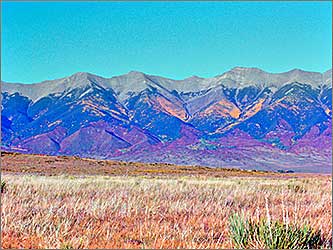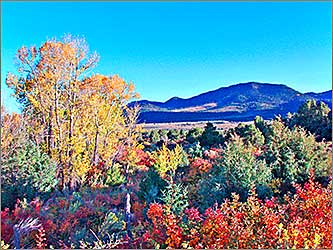Saguache County has seen mining since the early days, including gold and iron mining in the Sangre de Cristo mountains near Crestone and silver and other metals in the hills southwest of Saguache, but Bonanza in northern Saguache County, was a true Colorado boom town.
Rich silver ore was discovered in the mountains north of Saguache and west of Villa Grove in 1880, and the town of Bonanza sprang up that fall. The name comes from the optimistically named Bonanza mine; one of the prospectors told his friends, "It’s a Bonanza, boys!" and the name stuck. In 1880-81, 40,000 people passed through the area, including former president and Civil War general U. S. Grant in Augst of 1880, drawn by rumors that Bonanza was "the new Leadville".
Early strikes yielded silver ore worth $200 a ton, and in the 1880's the town of Bonanza boomed, with saloons, dance halls, a school, a town hall, plank sidewalks, daily stagecoaches, and even a town baseball team. An early town newspaper, the BONANZA BEE, featured the latest mine news and ads for livery stables, doctors, attorneys, groceries, hardware stores, clothing shops, drug stores, the two hotels, a cigar store, a bakery, a furniture store, a candy shop, and the bank. Three other small communities briefly flourished within a couple of miles of Bonanza, one boasting a brewery, a bowling alley, and a sawmill.
Several mills were built in the area to treat high-grade ores, and an estimated 1500 prospect holes and mines were opened before 1900. After the initial early discoveries, miners discovered that the deeper ores contained less silver and more lead, zinc, and copper and were harder to mine. Most of the mines and mills failed. Between 1890 and 1899, the population of the mining district fluctuated from 500 to as few as 100 people. In 1893, the Government stopped buying silver and the price dropped from well over $1.00 an ounce to about half that. Most of the surrounding federal lands became a part of the Rio Grande National Forest in 1908.
In 1911-1912, the owners of the Rawley Mine, the biggest mine in the district, built the mile-long Rawley 12 tunnel underground from Squirrel Gulch to beneath the existing mine workings to explore for additional ore and dewater the existing mine workings (which filled with water as fast as they could be pumped out). It cost more than $100,000 and took 17 months (this at a time when workers were paid $2 to $5 per day and a cord of wood cost $2).
Photos from 1917 show a major development at the Rawley 12 mine, including numerous buildings and a new method of getting ore out of the mine - the mule was, out and the electric locomotive was in! |
In 1921-23, a mill was built in Squirrel Gulch at the mouth of the Rawley 12 tunnel, and a 7 1/2 mile aerial tramway was built to haul concentrated ore north from the mill to the narrow gauge railroad line connecting with Salida. The route of the aerial tram over the hills is still visible today. When the mine went bankrupt, a new company was formed and produced about 320 tons of ore per day from 1925 to 1930 when the mine closed and the mill was scrapped.
Although the Bonanza mines were small by Colorado standards, tens of thousands of tons of metals came out of these hills over the years, including more than 150 tons of silver worth more than $20 million dollars today.
Most of the mines in the Bonanza area closed by the 1930’s. The end of the town of Bonanza almost came in the fire of 1937, when 30 buildings in the business section burned. The town has never been rebuilt, and just a few old houses, mine structures, and piles of rock remain from the boom days. Today, Bonanza is the smallest incorporated town in Colorado (pop. 10-15).
Since before the mines closed, environmental problems existed in the area. In the early 1990’s, the problems included dissolved metals in the creek water, mill waste too toxic to support plant life, and the creek through Bonanza was dead for several miles downstream. Today, the Forest Service, the State of Colorado, and others are working successfully to clean up contaminated sites and restore water quality
in this historic area.
Other points of interest in the Bonanza area include a former toll road built by Otto Mears (famous Colorado railroad builder and Saguache County pioneer), various cemeteries, and spectacular views of the aspen-covered hills where the prospectors once hoped to strike it rich. The Forest Service is establishing an interpretive loop for off-highway (high-clearance) vehicles around Bonanza, and this project will bring to life the rich history which is waiting to be discovered in the area. Additional the Brewery Creek Guard Station, a old Forest Service cabin near Bonanza, is available for rent by the public for stays throughout the year. For more information, please visit the Bonanza web site at www.bonanzaco.org or contact the Forest Service, Saguache Ranger District, at (719) 655-2547. |
Henrietta “Etta” Rader Johnson -
Modern Woman in the American West – A Brief Biography
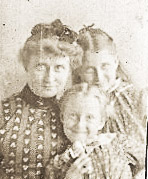 Henrietta “Etta” Rader Johnson was born January 6, 1870 at Camp Douglas, Utah Territory, a first child of Indiana native, Charles T. Rader and Swedish-born, Josephine Johnson. They were on their way to Fort Baker, Montana Territory where Charles was stationed after the Civil War. Etta was baptized before they left in the Episcopal Church on April 3. They arrived at Fort Baker by mule team and wagon in June of 1870. They established a ranch near the fort. The Raders had a total of ten children and became very prosperous and successful ranchers and members of the community. Henrietta “Etta” Rader Johnson was born January 6, 1870 at Camp Douglas, Utah Territory, a first child of Indiana native, Charles T. Rader and Swedish-born, Josephine Johnson. They were on their way to Fort Baker, Montana Territory where Charles was stationed after the Civil War. Etta was baptized before they left in the Episcopal Church on April 3. They arrived at Fort Baker by mule team and wagon in June of 1870. They established a ranch near the fort. The Raders had a total of ten children and became very prosperous and successful ranchers and members of the community.
neeRaderHeath Portrait.jpg)
When Etta was of age, she was sent to the Northern Indiana Normal School in Valparaiso, IN –and graduated in 1889 as one of nine women in a class of twenty-nine – the same year Montana became a state. She studied stenography and business. Also that same year she married Herbert Fletcher Paul, fourteen years her senior, who was employed as a fire insurance adjustor. She worked as his stenographer.
She moved in with his family – a Colonel James R. Paul and Rhoda Paul nee Groome Rainier - in Evansville, Illinois, a suburb with paved streets and sidewalks just outside Chicago. She gave birth to Beatrice who died from choking on popcorn just a few months after Colonel Paul died (probably from alcoholism brought on by mental and physical hardships in the Civil War) and a few months before Etta’s second daughter, Cora, is born in 1893. Gladys is born a short year later and sometime between 1895 and 1901 Etta divorces Herbert and moves to Bonanza, Co. with her two small girls to work as a hotel keeper (according to her life insurance policy dated 1901.)
The reason for the divorce is unclear but in those days, divorce was only granted in circumstances of “abandonment” or “extreme cruelty.” The death of Colonel Paul and then baby Beatrice, as well as the Panic of ’93 that hit mainly middle class families and then coupled with the fact that Herbert was a heavy drinker may well have all been contributing factors to the divorce. There is some evidence that he did not support his children financially after she left.
Bonanza had passed its heyday (less than 100 population) as a silver mining boom town by 1901 when it is documented Etta Paul is there with her two small daughters, so it is unclear why she chose to move there to run a boarding house. But it was her chance to claim her financial independence and put her degree to good use.
Etta was a photographer in that she valued recording certain elements of her life. There is evidence this interest grew out of her work in insurance as early insurance companies were using photography to document property and buildings to grant insurance coverage as well as record damage in order to pay out claims. Thus her photographs often seem documentary in nature rather than created for the sake of memories –although that does vary.
Photographs related to Bonanza:
High perspective pan view – mounted albumen print of the town of Bonanza in 1901 – according to the writing on the paper it was mounted on. (click image below to enlarge)
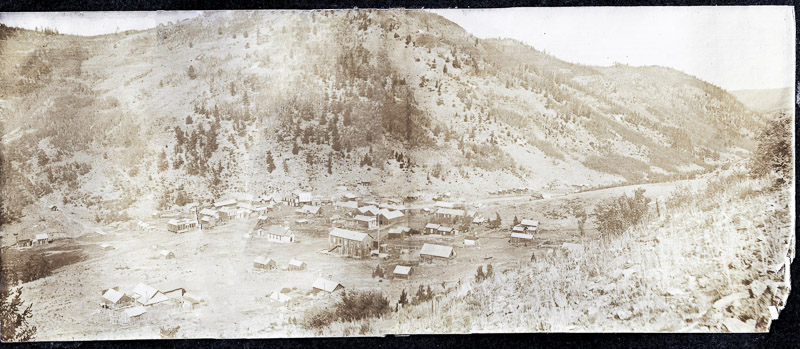
A mounted albumen print of “Canon House” which has not been documented to be located in Bonanza yet but is possibly the boarding house she managed there. It is the same photographic process and paper and based on it being mounted on board similar to others from that time frame – It could very well be the place she was employed in Bonanza.
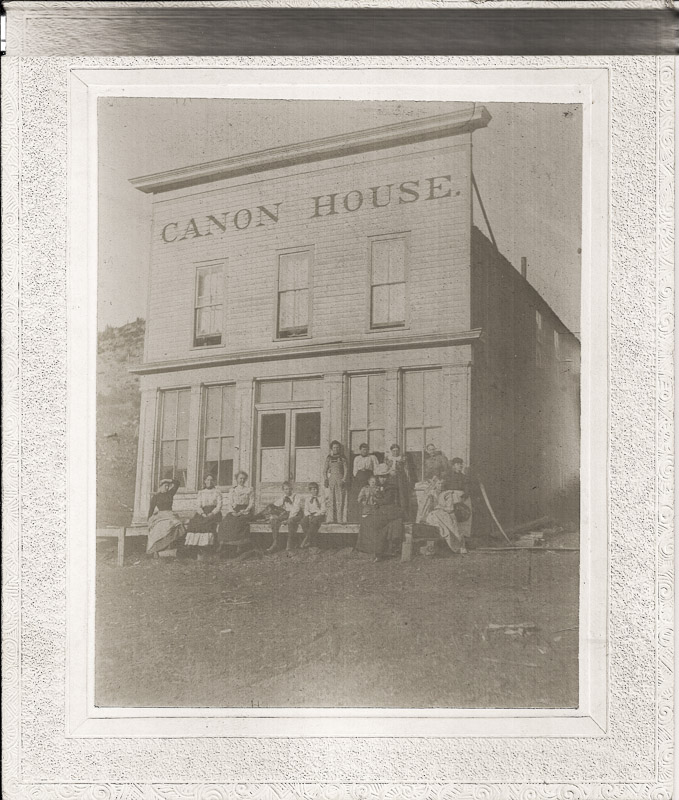
A mounted albumen print of a group of people at the top on the Ute Pass on their way back from the “Election” Dance in Saguache in 1901. The names of the people in the party are written on the back. Perhaps some of them are known in Bonanza documents. It would be interesting to know what route and method they traveled to attend a dance in Saguache as there was no direct route and there was no train. But it just goes to prove that a mountain pass was no barrier to young people wanting to socialize and have a good time.
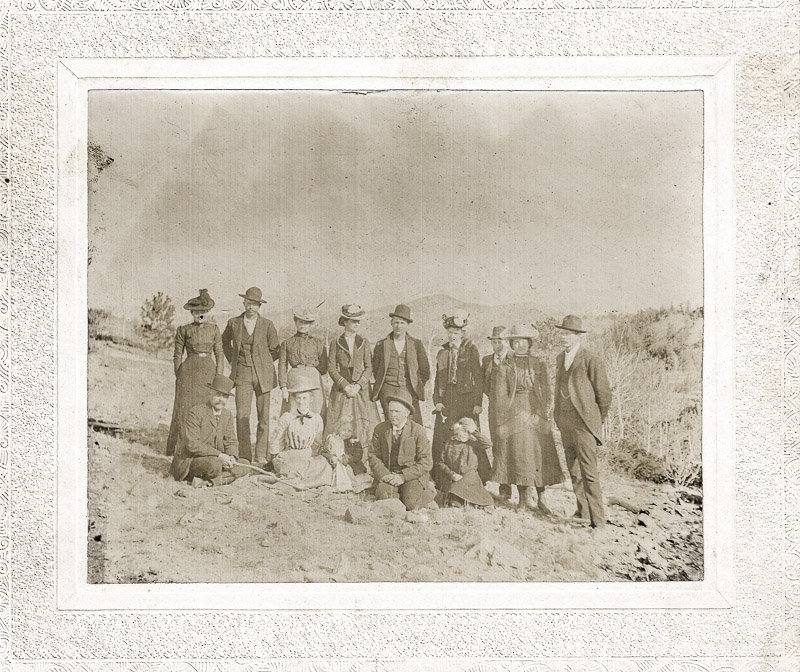

Etta married the love of her life, Max Sarter, in 1902 in Helena, Montana, so it is likely that she left Bonanza for good by then. She had a son, Maxie and raised her children, living out her life as a Montana Rancher in the Smith River Valley. She died on March 23, 1967 and was buried next to her husband, Max, in the Freemason section of the Mayn Cemetery in White Sulphur Springs Montana.
Researched & written by her great-great granddaughter
Professor Sonja S. Mongar, MFA
January 10, 2013
Moca, Puerto Rico
Photo credits
Please give photo credits to:
Etta Sarter/Sonja Mongar
I give permission for anyone to use the images and information as long as they give credit and let me know where and when and how it was used as well as provide me with any digital/links or materials so I can attach them or add them to my own archives and bibliography.
|
